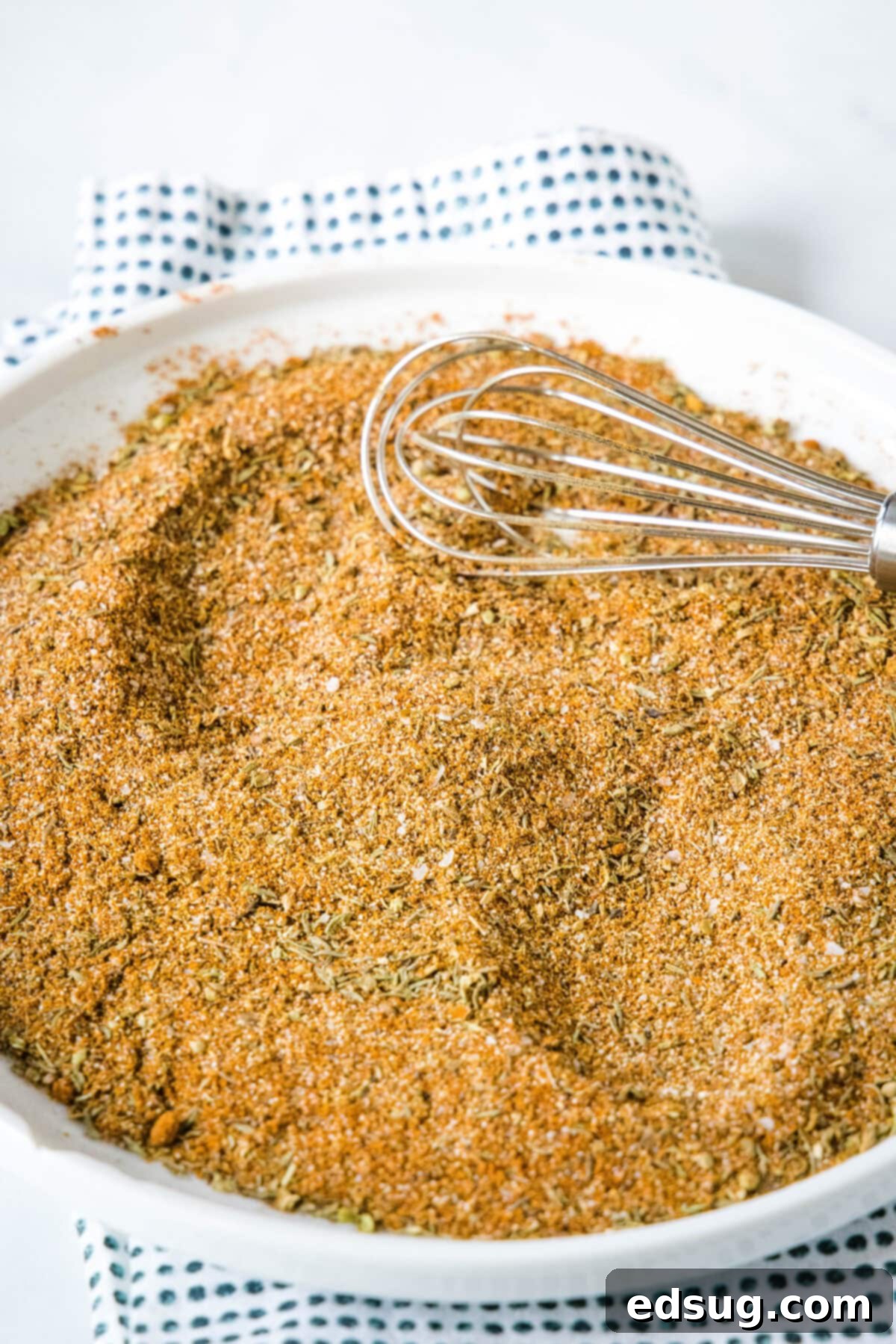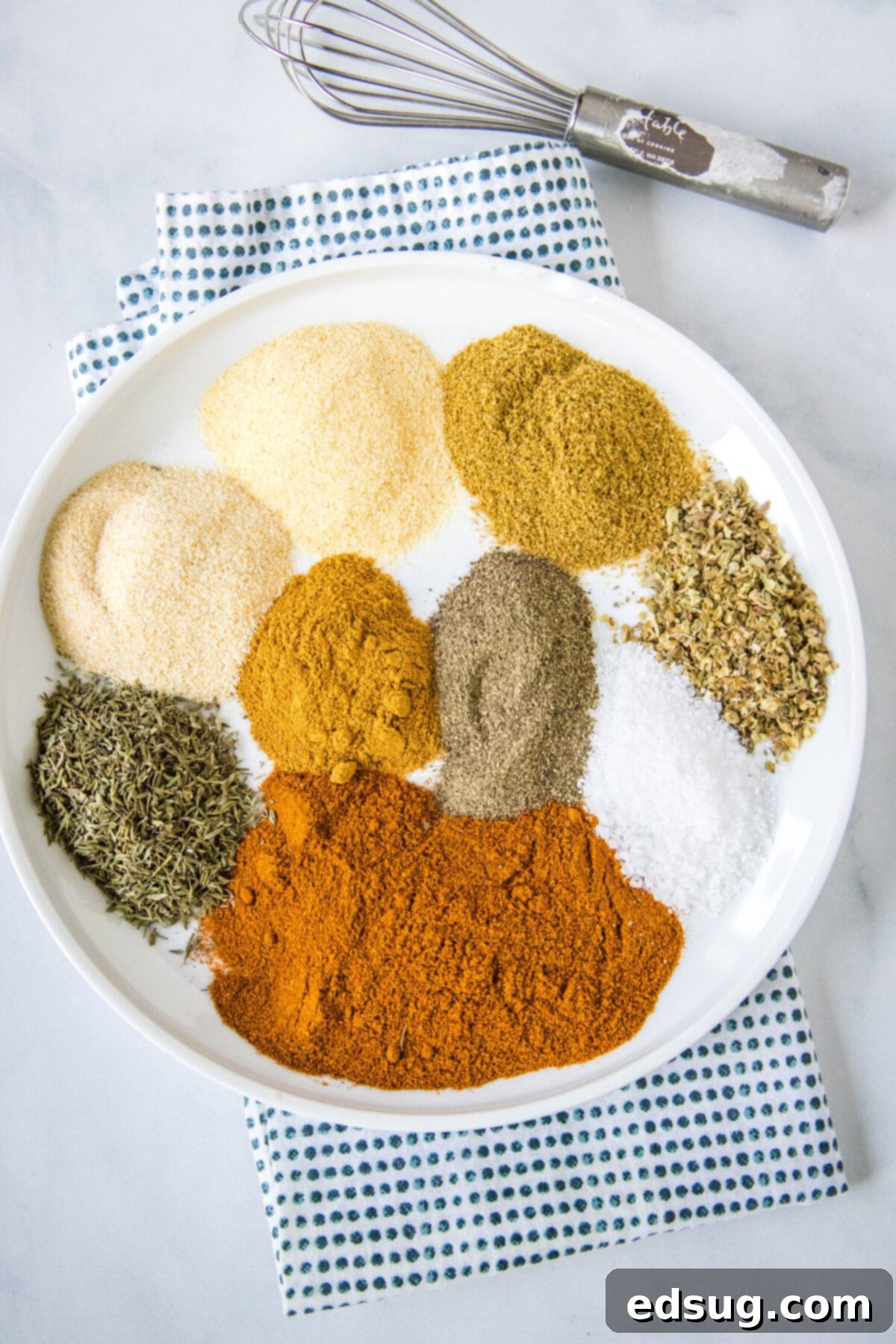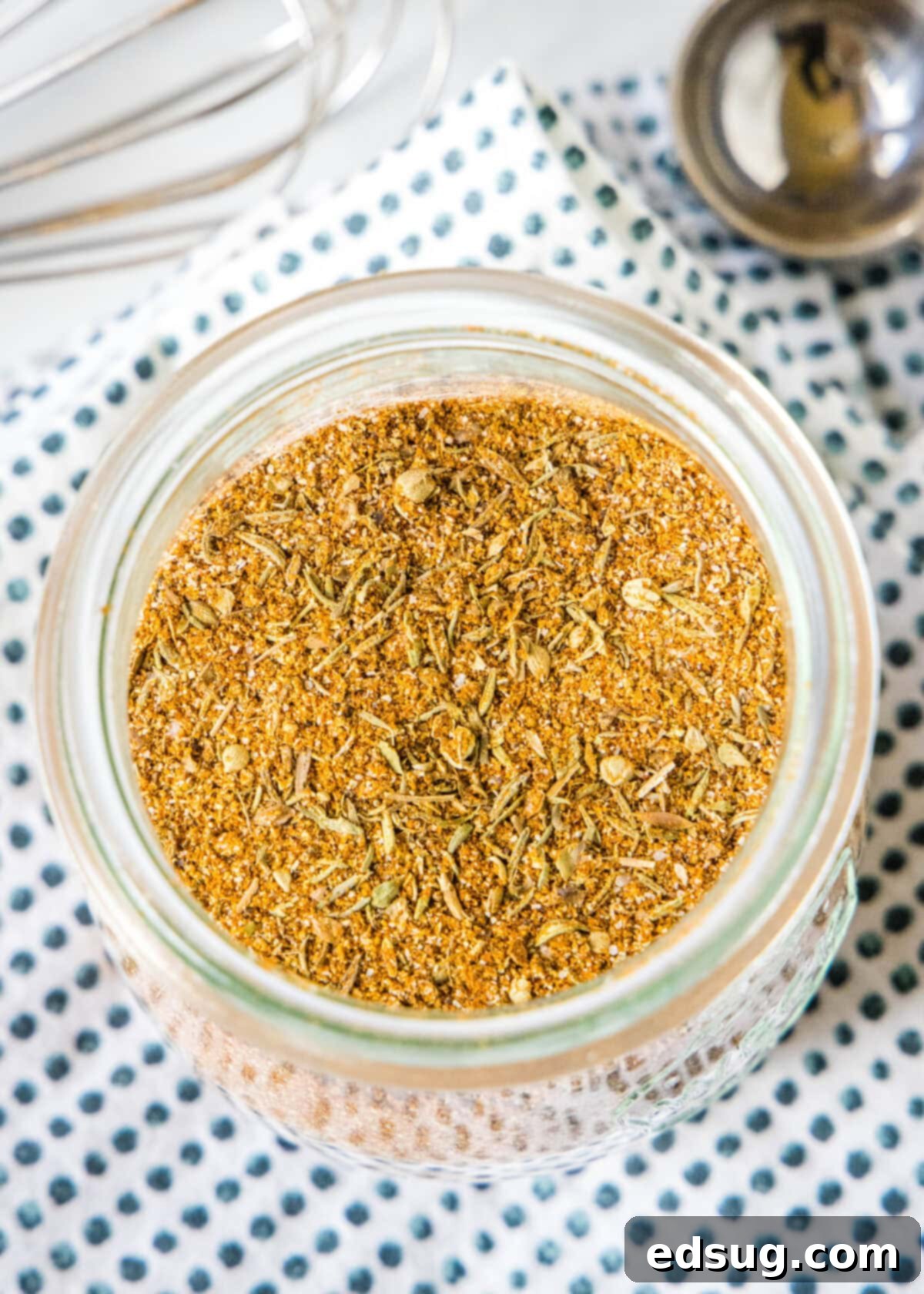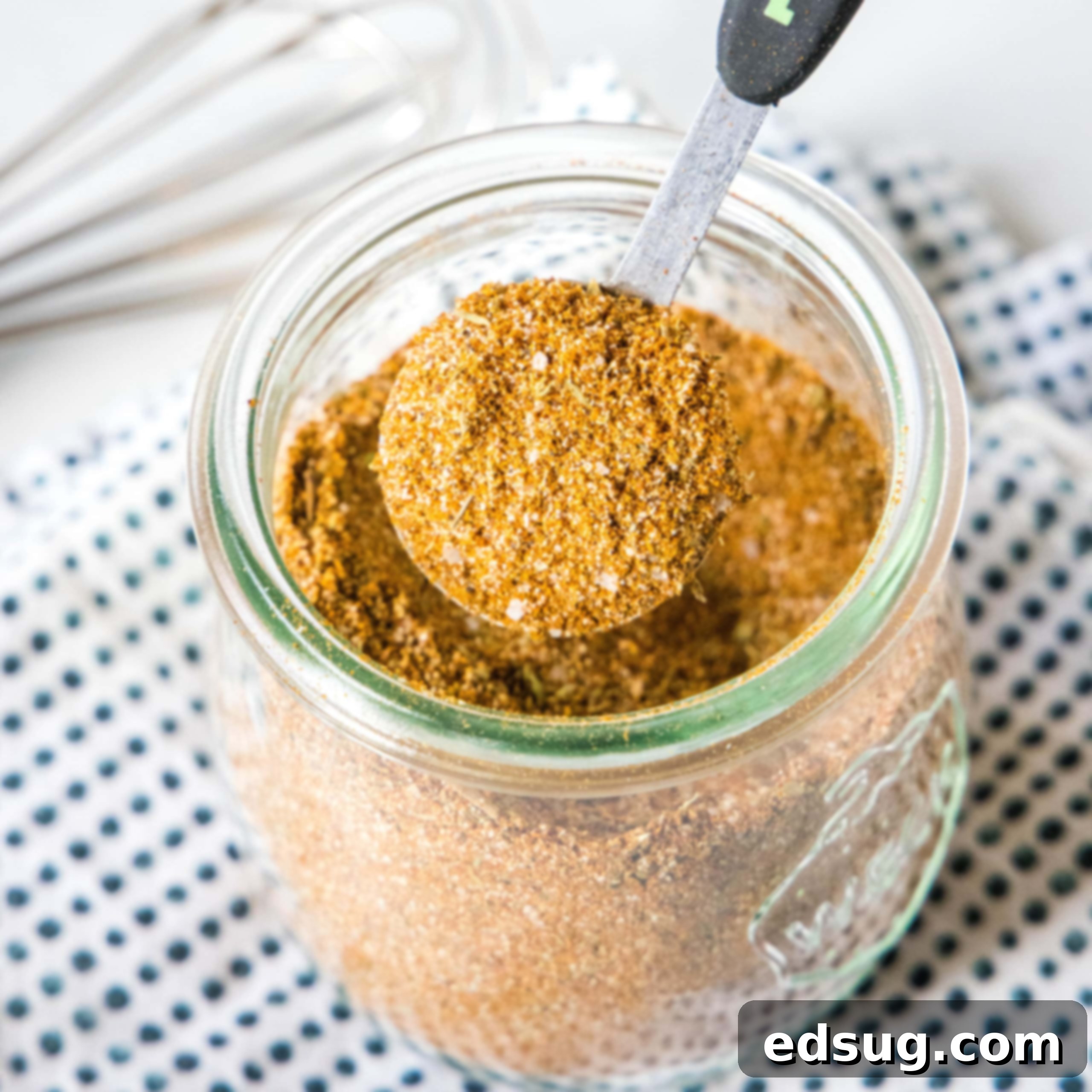Mastering Homemade Blackened Seasoning: Your Ultimate Guide to Flavorful Dishes
There’s an undeniable magic in creating your own spice blends at home. Not only do you gain complete control over the flavor profile, but you also ensure freshness and avoid unwanted additives. This Homemade Blackened Seasoning recipe is a prime example of such culinary alchemy. Ready in under 5 minutes, this robust blend can transform ordinary meals into extraordinary culinary experiences, elevating everything from blackened chicken to pan-seared fish. Once prepared, it’s a versatile secret weapon that stays potent and delicious in your pantry for months, ready to infuse your dishes with a deep, smoky, and spicy kick.
Making your own spice blends, like this exceptional blackened seasoning, is incredibly straightforward, especially if your spice rack is already well-stocked. The beauty of the DIY approach lies in customization. You become the master of your flavors, precisely adjusting the heat, the saltiness, or even adding a touch of sweetness to match your personal preferences. For instance, my Homemade Cajun Seasoning contains significantly less salt than many store-bought varieties, reflecting my taste. This control over ingredients is a game-changer for anyone looking to optimize flavor and tailor their cooking to specific dietary needs or desires.

What Exactly is Blackened Seasoning?
Blackened seasoning is a captivating blend of chili powder, aromatic herbs, and savory spices, often considered a flavorful cross between traditional Cajun and Creole seasonings. While it shares many common ingredients with its Southern cousins, its specific ratios and the technique it’s named after give it a distinct identity. The flavor profile is complex: it’s typically spicy, but not overwhelmingly so, offering a balanced warmth that enhances rather than overwhelms the main ingredient. For those who prefer a milder spice level, the amount of cayenne pepper in this recipe can be easily adjusted down, allowing you to fine-tune the heat to your liking.
A Brief History of Blackening
The “blackening” cooking technique, and by extension, the seasoning blend, gained widespread popularity in the 1980s thanks to Chef Paul Prudhomme, a renowned Cajun chef. He developed the method to create a flavorful, dark crust on fish, particularly redfish, without actually burning it. The process involves dipping a piece of protein (fish, chicken, or shrimp) into melted butter, then dredging it generously in a special blend of spices – our blackened seasoning – and finally searing it in a screaming hot cast-iron skillet. The combination of milk solids from the butter, the intense heat, and the spices creates a unique, charred-looking crust that locks in moisture and delivers an incredible depth of flavor. This technique quickly became a staple of Louisiana cuisine and spread throughout the world.

What You’ll Need: The Essential Blackened Seasoning Ingredients
Be sure to scroll to the bottom of the post for the FULL PRINTABLE recipe card with exact measurements.
The beauty of this homemade blackened seasoning is its reliance on common spices you likely already have in your pantry. Each ingredient plays a crucial role in building the complex and delicious flavor profile:
- Paprika – This is the cornerstone of the seasoning, providing rich color and a mild, sweet pepper flavor. You can opt for regular paprika for a classic taste or smoked paprika to add an extra layer of smoky depth, which beautifully complements the “blackened” effect.
- Dried Thyme – A quintessential herb in Southern cooking, dried thyme contributes an earthy, slightly minty, and aromatic note that grounds the blend and adds herbaceous complexity.
- Onion Powder – Offering a savory, umami base, onion powder provides a consistent flavor without the moisture of fresh onions, making it ideal for a dry spice blend.
- Garlic Powder – Another foundational aromatic, garlic powder delivers a pungent, savory kick that is indispensable for a robust spice mix. It partners perfectly with onion powder to create a depth of flavor.
- Ground Cumin – Cumin brings a warm, earthy, and slightly smoky flavor that adds an exotic touch and richness to the overall blend, distinguishing it from simpler spice rubs.
- Dried Oregano – Known for its strong, pungent, and slightly bitter notes, dried oregano adds another layer of herbaceousness, complementing the thyme and garlic beautifully.
- Kosher Salt – Essential for enhancing all the other flavors and crucial for the traditional blackening crust. Kosher salt’s larger flakes adhere well to food and provide a clean, briny taste.
- Black Pepper – Freshly ground black pepper adds a sharp, pungent heat that rounds out the spice profile and contributes to the overall warmth.
- Cayenne Pepper – This is your primary source of heat. Cayenne pepper delivers a clean, fiery kick. The amount used can be easily adjusted to make the seasoning milder or more intensely spicy, depending on your preference.
Some optional additions you might consider for an even more personalized blend include a pinch of brown sugar for a hint of sweetness and improved caramelization during cooking, or a touch of white pepper for a slightly different kind of heat and aroma.

How To Make Homemade Blackened Seasoning
Making this spice blend is incredibly simple, requiring minimal effort and time. It’s truly a dump-and-mix recipe!
- Combine All Ingredients: In a small bowl, simply add all the listed ingredients: paprika, dried thyme, onion powder, garlic powder, ground cumin, dried oregano, kosher salt, black pepper, and cayenne pepper.
- Mix Thoroughly: Use a whisk or a spoon to mix the spices together until they are completely combined and evenly distributed. You want to ensure there are no clumps and that every spoonful of the blend will have the same delicious balance of flavors.
- Store Properly: Transfer your freshly made blackened seasoning to an airtight container. A small glass jar with a tight-fitting lid is ideal, as it prevents air and moisture from degrading the spices.
Store your homemade blend in a cool, dark place, such as your pantry or a dedicated spice rack, away from direct sunlight and heat. When stored correctly, this blackened seasoning will retain its optimal flavor and potency for about 6 months, and potentially up to a year, depending on the initial freshness of your individual spices. For the best possible flavor, always aim to use the freshest spices you can find.
How To Use Blackened Seasoning: Beyond the Skillet
The name “blackened seasoning” originates from the traditional cooking method it’s famous for, which creates a dark, flavorful crust on proteins. However, its versatility extends far beyond that specific technique. This seasoning is a fantastic all-purpose blend that can add a savory, spicy, and earthy depth to a wide array of dishes.
The Traditional Blackening Method
Traditionally, blackening creates a deeply flavored, dark crust on food. To achieve this:
- Prepare your protein: Choose fish fillets (like catfish, snapper, tilapia, or salmon), chicken breasts, or shrimp. Pat them thoroughly dry.
- Dip in butter: Melt a good quality unsalted butter. Dip each piece of protein generously into the melted butter, ensuring it’s fully coated. The butter is crucial for the crust and flavor.
- Dredge in seasoning: Liberally dredge the butter-coated protein in your homemade blackened seasoning, pressing lightly to ensure a good coating on all sides.
- Sear in a hot pan: Heat a heavy-bottomed skillet, preferably cast iron, over very high heat until it just begins to smoke. The pan needs to be intensely hot. Add a small amount of high-smoke-point oil (like avocado oil) or clarified butter if not using butter directly on the pan. Place the seasoned protein in the hot skillet.
- Cook to perfection: Sear for only 1-3 minutes per side, depending on the thickness of your protein, until a dark, flavorful crust forms. The high heat and spices create this characteristic “blackened” appearance and incredible flavor. Make sure you have good ventilation, as this method produces a lot of smoke!
Some of my favorite traditional blackened dishes include Blackened Chicken, which is fantastic sliced over salads or in wraps, and Blackened Shrimp Pasta, a hearty and flavorful meal perfect for weeknights.

Beyond Blackening: Other Versatile Uses
You can truly use this blend like any other all-purpose spice mix. Its robust flavor profile makes it suitable for countless applications:
- Grilling, Baking, or Sautéing: Simply sprinkle it generously over chicken, pork chops, beef steaks, or even firm fish fillets before grilling, baking, or sautéing. It adds a fantastic crust and flavor without the intense smoke of the traditional blackening method.
- Roasted Vegetables: Give your roasted potatoes, sweet potatoes, corn on the cob, asparagus, or bell peppers a delightful kick by tossing them with a little olive oil and blackened seasoning before roasting.
- Marinades and Rubs: Combine the seasoning with a bit of olive oil, lemon juice, or vinegar to create a quick marinade for poultry or seafood. It also works wonders as a dry rub for ribs or roasts.
- Soups and Stews: Stir a teaspoon or two into gumbos, jambalayas, chili, or even a simple vegetable soup to deepen the flavor and add a touch of warmth.
- Eggs and Breakfast Dishes: A sprinkle of blackened seasoning over scrambled eggs, omelets, or even avocado toast can transform your breakfast into a vibrant, flavorful meal.
- Dips and Sauces: Mix a small amount into creamy dips like sour cream or yogurt-based sauces for a zesty, spicy dip that pairs well with chips or crudités.
- Popcorn or Nuts: For a savory snack, toss freshly popped popcorn or roasted nuts with a sprinkle of this seasoning.
Recipe Tips & Tricks for the Best Blackened Seasoning
- Start with Fresh Spices: This is arguably the most important tip. While spices don’t technically “go bad” in a way that makes them unsafe to eat, they do lose their potency and flavor over time. If your spices are already six months old when you start, your homemade blend will lose its vibrant flavor very quickly. For the most impactful seasoning, use spices that are relatively fresh (purchased within the last 6-12 months). A good test for freshness is to smell them – if they don’t have a strong aroma, their flavor will be diminished.
- Proper Storage is Key: Just like your individual spices, this blend thrives when stored correctly. Keep it in an airtight container (like a glass jar with a tight lid) in a cool, dark place such as your pantry or a kitchen cabinet, away from direct sunlight and heat sources (like the stove). This will help preserve its flavor for as long as possible.
- Get Creative with Usage: Don’t limit yourself to traditional blackening! As mentioned, this seasoning is incredibly versatile. I love sprinkling it over roasted vegetables and potatoes to give them an unexpected and delicious kick. It might not be traditional, but it’s a fantastic way to elevate everyday sides. Consider adding it to rice, beans, or even a dash in your homemade salad dressings.
- Adjust Spice Levels: Always remember that the amount of cayenne pepper is completely customizable. If you prefer a milder flavor, start with half the recommended amount and add more to taste. For serious heat lovers, feel free to increase it.
- Consider Grinding Your Own: For an even fresher and more aromatic blend, consider starting with whole spices like cumin seeds, whole peppercorns, or even dried oregano leaves, and grinding them yourself just before mixing. A spice grinder (or a clean coffee grinder) makes this easy and yields a significantly more potent and flavorful result.
- Ventilation for Blackening: If you plan to use the traditional blackening method, ensure you have good kitchen ventilation. The high heat involved produces a fair amount of smoke. Open windows, turn on your range hood, and be prepared for some smoky air.
More Homemade Spice Blends to Explore
Once you discover the ease and superior flavor of homemade spice blends, you might never go back to store-bought! Here are a few more fantastic blends to try:
- Homemade Chicken Seasoning
- Perfect Pork Chop Seasoning
- Homemade Taco Seasoning
- Classic Italian Seasoning
- Zesty Fajita Seasoning

Blackened Seasoning
Pin Recipe
Rate Recipe
Print Recipe
Ingredients
- 2 Tablespoons paprika
- 2 teaspoons dried thyme
- 2 teaspoons onion powder
- 2 teaspoons garlic powder
- 2 teaspoons cumin
- 2 teaspoons dried oregano
- 2 teaspoons kosher salt
- 2 teaspoons black pepper
- 2 teaspoons cayenne pepper
Instructions
-
Mix together all ingredients until well blended.
-
Store in an airtight container for up to 6 months.
Notes
Nutrition
Nutrition information is automatically calculated, so should only be used as an approximation.
Additional Info
Like this recipe? Leave a comment below!
I created a fun group on Facebook, and I would love for you to join us! It’s a place where you can share YOUR favorite recipes, ask questions, and see what’s new at Dinners, Dishes and Desserts (so that you never miss a new recipe)!
Be sure to follow me on Instagram and tag #dinnersdishes so I can see all the wonderful DINNERS, DISHES, AND DESSERTS recipes YOU make!
Be sure to follow me on my social media, so you never miss a post!
Facebook | Twitter | Pinterest | Instagram
.
